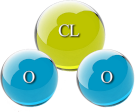Chlorine dioxide drinking water test as an indication of oxygen deficiency or increased oxygen demand by means of lactate determination in capillary blood before and after administration of the oxygen donor ClO2 (Chlorine dioxide) in drinking water
Impact of Oxygen Deficiency
In situations where oxygen availability is significantly limited—such as during the aging process, periods of intense physical exertion, or in the presence of chronic diseases like cardiac insufficiency—along with respiratory weakness, or conditions such as Long Covid—the body adapts by resorting to a metabolic pathway known as partially anaerobic glycolysis. This alternative metabolic pathway is crucial under these circumstances, as it allows the body to continue producing energy despite the lack of sufficient oxygen. However, it is important to note that this method of energy production is less efficient than aerobic respiration, yielding only 2 moles of ATP per mole of glucose consumed. Additionally, this process leads to the generation of lactic acid, which can be detected in the bloodstream as lactate. The accumulation of lactate can have various physiological implications and may contribute to feelings of fatigue and muscle discomfort.
Lactate Measurement Procedure
The Lactate Pro 2 measuring device from ARKRAY is employed for lactate measurements. The sensitivity of this device necessitates strict adherence to the testing protocol:
- Pre-Test Preparations:
- Avoid vitamin C and N-acetyl-cysteine (NAC) supplements for at least 2 hours prior to testing, as they may elevate lactate levels.
- Abstain from eating for one hour before the test.
- Avoid chlorine dioxide (CDL) intake, physical exertion, and stress, as these can also affect lactate levels.
- Test Conditions:
- The subject should remain seated and refrain from emotional discussions for 10 minutes before testing.
- Wash the fingers of the test hand with soap and dry them.
- At minute 9, rinse fingers with water to remove sweat containing lactate.
- Testing Steps:
- Open a test strip and insert it into the device 30 seconds before testing.
- Use a lancet to puncture the finger, allowing a small drop of blood to form without squeezing excessively.
- Position the test strip vertically to the blood drop until the device beeps, then wait 15 seconds to read the result.
Normal Values and Interpretation
- Normal lactate levels range from 0.5 to 2.2 mmol/L, with typical resting values between 0.5 and 1.0 mmol/L.
- A variation/accuracy of ±20% is expected with this test.
For lactate values exceeding 1.0 mmol/L, administration of 6 ml of 0.3% chlorine dioxide solution diluted in 200 ml of tap water is recommended. Re-testing after 5 minutes can indicate effectiveness if there is a reduction of >20%, suggesting relative oxygen deficiency in the body.
Clinical Implications
In individuals with chronic conditions such as type 2 diabetes, lactate levels can be 2-3 times higher compared to healthy populations. Elevated lactate (>2.2 mmol/L) denotes clinical oxygen deficiency, while values between 1.0-2.2 mmol/L with a positive CDL test indicate subclinical oxygen deficiency.
Case Example
For instance, an individual aged 77 had a baseline lactate value of 2.9 mmol/L on July 23, 2023. After ingesting chlorine dioxide solution:
- 5 minutes later: Lactate decreased to 1.4 mmol/L (a reduction of >20%).
- 10 minutes later: Further decrease to 1.2 mmol/L.
This suggests an improvement in oxygen availability, indicating that further administration of chlorine dioxide may be beneficial.
Conclusion
Chlorine dioxide, when used within specified non-toxic doses, is believed to enhance oxygen partial pressure throughout the body and possesses potential deacidifying and anti-infectious properties. Understanding lactate dynamics and oxygen availability is crucial for managing chronic conditions and optimizing physical performance.
References
- Flexikon.doccheck.com/de/Laktat
- Dariusalamouti.de/schoenheitslexikon/l/laktat-und-laktatschwelle
- Harthum, T. Analysis of Exercise-Dependent Blood Lactate Concentration during Outpatient Cardiac Rehabilitation (Master's Thesis, University of Vienna, 2015).
- Fitbook.de/fitness/was-ist-laktat-1
- Gesundheits-lexikon.com/labormedizin-Labordiagnostik/sonstiges/Laktat.html
- Medicoconsult.de/laktat/
- Flexikon.doccheck.com/de/Laktat
- ScienceDirect.com/science/article/pii/S2095254620300193
- Supplement to the Lactate Pro 2 Test Strip
- Senslab.de Sources of Error and Notes on Sampling for Lactate Measurements
- Federal Environment Agency Guidelines on Drinking Water Treatment Substances (Status January 2023).
